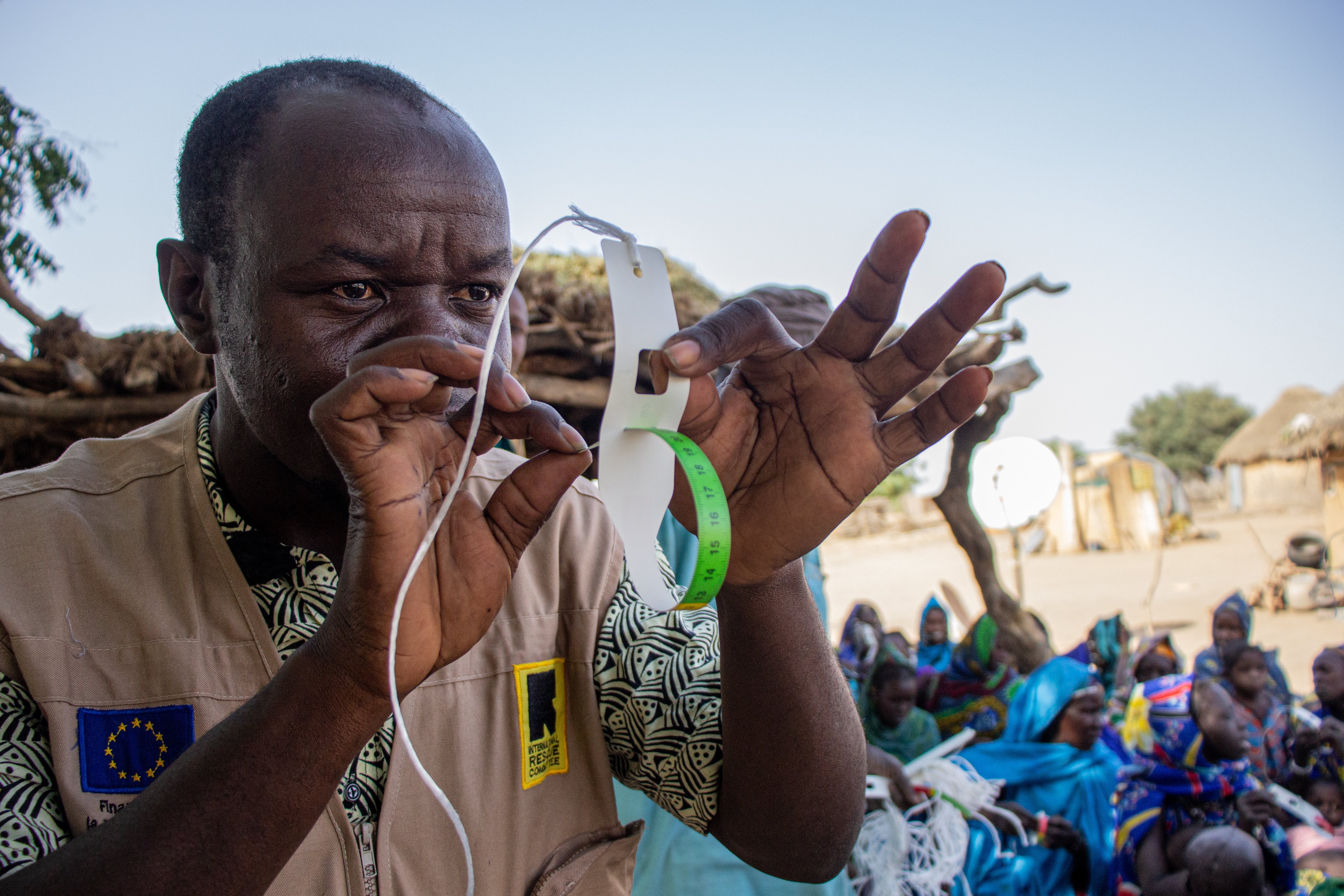
Malnutrition
Scaling Treatment for Acute Malnutrition
The Problem
The IRC estimates that 18 million children living in humanitarian crises are suffering from acute malnutrition at any given time, despite the existence of a proven solution - a simple packet of fortified peanut butter paste. However, only 20% of acutely malnourished children are accessing this treatment, despite its known effectiveness. In addition, up to 30% of children relapse within 6 months from finishing treatment.
Why current approaches are inadequate
The current system cannot finance treatment for all children in need, and there is growing momentum for more localized, context-specific solutions, particularly in lower-risk settings. At the same time, current treatment approaches often fall short in supporting children’s long-term recovery. Many children require repeated treatment episodes due to relapse, driven by a return to chronically poor diets and frequent illness after discharge.


Our solution
1. Simplified Combined Protocols to Expand Treatment Coverage in High-Risk Areas
This approach uses an easy-to-follow system based on a color-coded, numbered measuring tape to diagnose malnutrition, combined with a ready-to-use therapeutic food (RUTF), a nutrient-rich peanut paste. Community Health Workers (CHWs) play a crucial role by delivering this life-saving care directly within communities. This simplified protocol is scalable, less costly, and proven effective in helping malnourished children recover. Studies show it can reduce treatment costs by around 20% per child and use 25% less nutritional product compared to traditional methods.
2. Post-Discharge Monitoring and Supplementation with SQ-LNS
After children recover from malnutrition, regular follow-up visits at health centers allow for ongoing monitoring of their health and development. During these visits, children receive high-quality nutritional supplements called Small-Quantity Lipid-based Nutrient Supplements (SQ-LNS). This ongoing support can significantly lower relapse rates and help children move beyond survival to truly thrive.
3. Sustainable Treatment Solutions for Moderate Malnutrition in Low-Risk Settings
In areas where access to specially formulated therapeutic foods is limited, this approach focuses on designing cost-effective and sustainable strategies to support children with moderate malnutrition, ensuring they receive appropriate care tailored to local contexts.
Shifting the status quo
IRC has been researching simplified approaches for treatment of acute malnutrition for a decade and the body of research is now significant. The evidence is consistent that simplified approaches, including middle-upper-arm-circumference tab-based and simplified dosing, are more cost-effective ways to treat acute malnutrition with the same recovery rates compared to the original protocol. We therefore support the range of simplifications and adoption of all effective simplified approaches, including those in the WHO wasting treatment guidelines, that expand reach of treatment and/or result in reduced costs. The humanitarian sector should adopt simplified approaches as the standard of care for acute malnutrition. This is part of IRC's Movement Against Malnutrition.
Related Projects
Piloting the use of the ComPAS style protocol
Although a proven treatment for malnutrition exists, less than 1 in 5 acutely malnourished children receive it. A better system can ensure every child receives the care they need.
Explore ProjectComPAS: Combined Protocol for Severe and Moderate Acute Malnutrition Study
Streamlining malnutrition treatment to reach more children, more effectively
Explore ProjectContextually Adapted Family MUAC
Supporting mothers and caregivers to identify child malnutrition in their communities
Explore ProjectCommunity Health Worker-led Treatment of Acute Malnutrition
Reaching the last mile by equipping community health workers to treat acute malnutrition in their communities
Explore ProjectRelapse after treatment of acute malnutrition
Relapse post-discharge from acute malnutrition treatment remains a largely neglected issue
Explore ProjectSQ-LNS to reduce relapse post-discharge from acute malnutrition treatment
Small-quantity lipid-based nutrient supplements (SQ-LNS) hold promise for preventing relapse in an efficient and cost-effective way
Explore Project
Latest Updates
-
Linear Growth During Treatment With a Simplified,Combined Protocol: Secondary Analyses of SeverelyWasted Children 6–59 Months in the ComPAS ClusterRandomized Controlled Trial
A secondary analysis of the ComPAS trial in Kenya and South Sudan compared growth outcomes in children with severe acute malnutrition (SAM) treated using a simplified protocol (fixed RUTF dose) versus the standard weight-based dosing protocol. The results showed similar linear growth, weight gain, and MUAC improvements in both groups, indicating that a lower, simplified RUTF dose can effectively support recovery in children with SAM.
External link -
Perceptions of stakeholders on the use of a simplified, combined protocol for treatment of acute malnutrition in Central African Republic
In a cross-sectional mixed-methods study conducted in two districts of the Central African Republic (CAR), most stakeholders expressed a clear preference for the simplified protocol over the standard one. They found it easier to understand, more inclusive, and effective for treating acute malnutrition. The broader admission criteria and use of mid-upper arm circumference (MUAC) measurements were especially well received.
External link -
The relationship between energy provided and growth during severe wasting treatment
A secondary analysis of the Mali pilot examined the relationship between energy intake and growth outcomes in the treatment of severe wasting, aiming to optimize nutritional interventions. The findings showed that children who received higher energy intake at the start of treatment gained weight more quickly and demonstrated greater overall growth. However, determining the healthiest and most sustainable rate of growth remains a critical question for informing treatment guidelines.
External link -
Effectiveness of acute malnutrition treatment with a simplified, combined protocol in Central African Republic: An observational cohort study
The simplified, combined protocol with a mid-upper-arm circumference (MUAC)-based ready-to-use therapeutic food (RUTF) resulted in a recovery rate that reached SPHERE standards, low length of stay and low RUTF consumption per child among all children treated.
External link -
Nutritional treatment of children 6–59 months with severely low weight-for-age z-score: a study protocol for a 3-arm randomized controlled trial
Nutritional treatment of children 6–59 months with severely low weight-for-age z-score: a study protocol for a 3-arm randomized controlled trial
External link -
Optimising ‘family MUAC’: Findings from a pilot study in Mali
Worldwide, only 20% of an estimated 50 million children afflicted by severe wasting receive life-saving treatment each year. The biggest gap to treatment coverage is identification of cases and referrals to treatment.
External link -
The effect of age rounding on weight-for-age z-scores: Evidence from Sub-Saharan Africa
Children aged 6–59 months are classified as malnourished when their weight-for-age z-score (WAZ) is lower than minus two standard deviations (< -2 SD) below the median on the 2006 World Health Organization growth standards (WHO, 2006).
External link -
No child faces: Examining the use of child images from nutrition assessments
The use of child images, particularly in the humanitarian sector, is problematic. In the worst cases, child images are used by nonprofits and charity organisations to gain sympathy and donations by showing exploitative imagery of people living in destitute conditions – referred to as ‘poverty porn’.2 More ubiquitously, pictures of identifiable minors in humanitarian contexts continue to be relied on for internal communications, fundraising campaigns, technical guidelines, articles, case studies, grey literature, and donor reports. This is despite existing guidelines and the sector espousing a central ‘Do no harm’ principle.
External link -
Cost-efficiency of a simplified protocol for wasting treatment in Mali
The treatment of wasting is currently divided into separate programmes based on severity. Uncomplicated severe wasting is treated through outpatient therapeutic feeding programmes, whereas moderate wasting is often treated through supplementary feeding programmes. While wasting is essentially a spectrum from mild to moderate to severe – with cutoffs acting as necessary proxy thresholds to designate treatment – these treatment programmes often run independently from each other with different sites, treatment days, and using different products with their own supply chains.
External link -
Post-Recovery Relapse of Children Treated with a Simplified, Combined Nutrition Treatment Protocol in Mali: A Prospective Cohort Study
The present study aimed to determine the 6-month incidence of relapse and associated factors among children who recovered from acute malnutrition (AM) following mid-upper arm circumference (MUAC)-based simplified combined treatment using the ComPAS protocol
External link